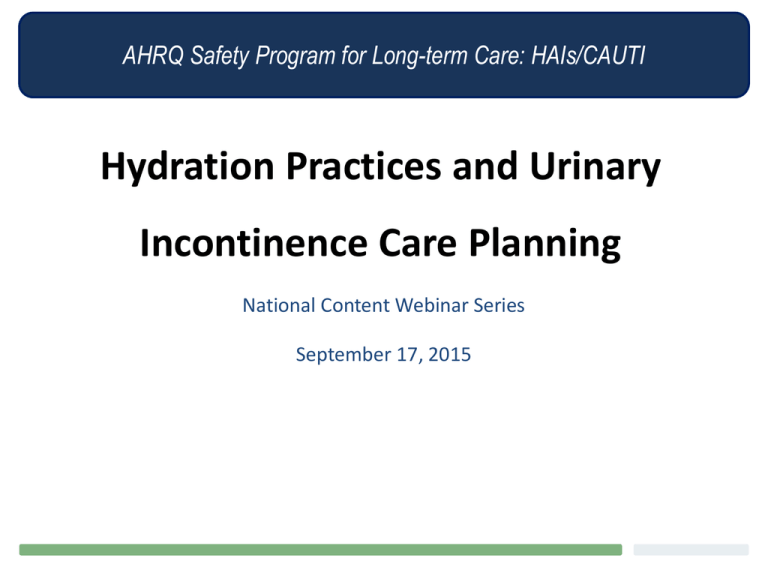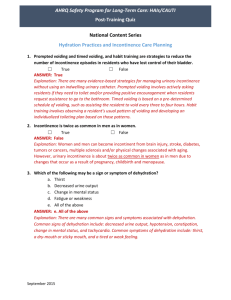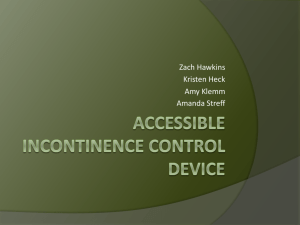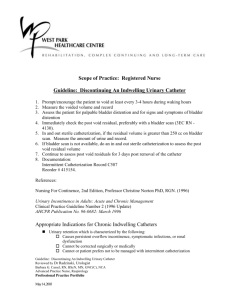AHRQ Safety Program for Long-term Care: HAIs/CAUTI Project
advertisement

AHRQ Safety Care:HAIs/CAUTI HAIs/CAUTI AHRQ SafetyProgram Program for for Long-term Long-term Care: Hydration Practices and Urinary Incontinence Care Planning National Content Webinar Series September 17, 2015 Objectives Upon completion of this training, participants will be able to: • Identify evidence-based practices (EBP) relative to resident hydration and incontinence care planning; • Demonstrate how resident hydration and incontinence care planning practices can reduce indwelling urinary catheter use and CAUTI; and • Demonstrate communication strategies to engagement resident and family members with hydration practice and incontinence care planning. What is Urinary Incontinence (UI)? • Involuntary loss of bladder control — Urinary leakage • Nursing home facilities ― Short-term residents: 36.7% report urinary leakage ― Long-term residents: 79.3% report urinary leakage • Both women and men can become incontinent from localized tumor/cancer, diabetes, neurological disorders and physical changes associated with aging Images source National Kidney and Urologic Gornia et al. June 2014. Prevalence of Incontinence Among Older Americans. Vital and Health Statistics. CDC. http://www.cdc.gov/nchs/data/series/sr_03/sr03_036.pdf Disease Information Clearinghouse, accessed on 9/16/2015. 3 How Does UI Impact Emotional Well-being? • Reduces social engagement • Lowers participation in other activities • Increases risk of reduced sensory stimulation • Lowers quality of life • Lowers levels of personal care 4 Medical Indications for Catheter Insertion Inappropriate Catheter Use X Urinary incontinence X Immobility Appropriate Catheter Use Urinary retention Bladder outlet obstruction To assist in healing perineal /sacral wounds Prolonged immobilization End of life comfort Accurate output measurement in the critically ill Perioperative for selected surgical procedures of the genitourinary tract or long procedures Faikh MG et al. AJIC 2014;S223-S229. Clinical indicators for Catheters (2009): http://www.cdc.gov/hicpac/pdf/CAUTI/CAUTIguideline2009final.pdf 5 Habit Training Catheter Alternatives for UI: Evidence-based Practice (EBP) Target group • All Procedure • Identify resident’s natural voiding pattern • Create an individualized toileting schedule Best Research Evidence Outcome • • Number of incontinent episodes Pad change due to incontinence in 24 hours EBP Clinical Expertise Patient Values Comments • Requires early planning, staff buy-in and consistent adherence Image concept from Sackett DL, Rosenberg WM, Gray JA, Haynes RB, Richardson WS. Evidence based medicine: what it is and what it isn’t. BMJ. 1996;312:71-72 CMS Manual System. June 2005. Department of Health and Human Services (DHHS), Centers for Medicare & Medicaid Services (CMS) https://www.cms.gov/Regulations-and-Guidance/Guidance/Transmittals/downloads/r8som.pdf 6 Prompted vs. Timed Voiding Catheter Alternatives for UI: Evidence-based Practice (EBP) Prompted Voiding Timed Voiding Target group Target group • Cognitively and/or physically impaired • Procedure • • • Verbal prompt to ask the residents if they are wet or dry & if they need toilet assistance Physical assistance to reach the bathroom Positive reinforcement Outcome • Self-initiated requests • Number of incontinent episodes Comments • Labor intensive, requires staff buy-in and consistent adherence Residents not capable of independent toileting; usually cognitively impaired Procedure • Fixed intervals between toileting assistance Outcome • • • Number of incontinent episodes Pad change due to incontinence in 24 hours Maintenance of skin integrity Comments • Consider passive toileting assistance programs; requires staff adherence CMS Manual System. June 2005. Department of Health and Human Services (DHHS), Centers for Medicare & Medicaid Services (CMS) https://www.cms.gov/Regulations-and-Guidance/Guidance/Transmittals/downloads/r8som.pdf 7 Other Catheter Alternatives for UI Evidence-based Practice (EBP) Treatment Medications Absorbent Pads • Oxybutynin • Mainstay for UI containment • Tolterodine • Should be based on resident’s needs and preferences • Trospium • Darifenacin • Solifenacin • Fesoterodine • F-tag 315: Should only occur after an appropriate evaluation and after alternatives are considered 8 HYDRATION PRACTICES 9 Dehydration Definition, Causes and Risks Dehydration = Abnormal depletion of body fluids Causes – Increased fluid loss due to acute illness, medication, environment – Decreased fluid intake as a result of decreased thirst perception, difficulty swallowing, intentional decrease in intake to prevent incontinence Residents At Risk for Dehydration • • • • • Restricted diets, enteral nutrition, thick liquids Communication problems Medications Functional impairment (unable to feed self) Cognitive impairment/Dementia • • • • Chronic diseases (kidney, diabetes, cardiovascular) Depression Fever/infection Vomiting/Diarrhea 10 Signs and Symptoms of Dehydration Signs Symptoms • Decreased urine output • Thirsty • Hypotension • Dry, sticky mouth • Constipation • Tired, feeling weak • Change in mental status • Tachycardia Change in mental status Dry Mouth Constipation and/or Decreased urine output Hypotension and/or Tachycardia Tired and/or Feeling weak 11 How to Prevent Dehydration • Involve the dietary and nutrition teams • Provide foods high in water content • Provide liquids before and with meals • Provide liquids between meals and with medication passes • Encourage each resident to drink fluids and offer fluid preferences • Develop targeted care plans to prevent dehydration/re-hydrate • Ensure good mouth care • Track and review fluid intake 12 Strategies to Improve UI and Hydration Management at Your Facility • Assess residents at risk for dehydration and urinary incontinence • Include hydration as a topic in safety discussions • Engage residents, families and volunteers to support hydration and incontinence care planning and activities • Celebrate often and serve refreshments to residents! 13 Stay Updated with Useful Resources 1. AHRQ Safety Program for Long-term Care: HAIs/CAUTI Project Website Login information Username: ltcsafety Password: ltcsafety 2. TeamSTEPPS® for Long-term Care 3. LTC Safety Toolkit 4. Learn From Defects Tool 5. National Content Webinar: Training LTC Facility Staff on Catheter Insertion & Maintenance to Prevent CAUTIs 6. Bowel and Bladder Elimination Toolkit – Mountain-Pacific Quality Health 14 References Centers for Disease Control and Prevention. Healthcare Infection Control Practices Advisory Committee (HICPAC) approved guidelines for the Prevention of catheter-associated urinary tract infections, 2009. Available at http://www.cdc.gov/hicpac/pdf/CAUTI/CAUTIguideline2009final.pdf. Centers for Disease Control and Prevention. Identifying Healthcare-associated Infections (HAI) for NHSN Surveillance (online). Accessible at: http://www.cdc.gov/nhsn/PDFs/pscManual/2PSC_IdentifyingHAIs_NHSNcurrent.pdf. Clinical indicators for Catheters (2009): http://www.cdc.gov/hicpac/pdf/CAUTI/CAUTIguideline2009final.pdf Faikh MG et al. AJIC 2014;S223-S229 Gornia et al. June 2014. Prevalence of Incontinence Among Older Americans. Vital and Health Statistics. CDC. http://www.cdc.gov/nchs/data/series/sr_03/sr03_036.pdf National Healthcare Safety Network (NHSN). Long-term Care Facility (LTCF) Component Healthcare Associated Infection Surveillance Module: UTI Event Reporting [online]. Prompted Voiding for Management of Urinary Incontinence Among Older Adults. Annals of Long-Term Care. http://www.annalsoflongtermcare.com/news/prompted-voiding-urinary-incontinence-older-adults Ouslander JG, Schnelle JF, Uman G, et al. Predictors of successful prompted voiding among incontinent nursing home residents. JAMA. 1995;273:1366–137. Stone ND, Ashraf MS, Calder J. Surveillance Definitions of Infections in Long-Term Care Facilities: Revisiting the McGeer Criteria. Infect Control Hosp Epidemiol 2012;33(10):965-977. 15





